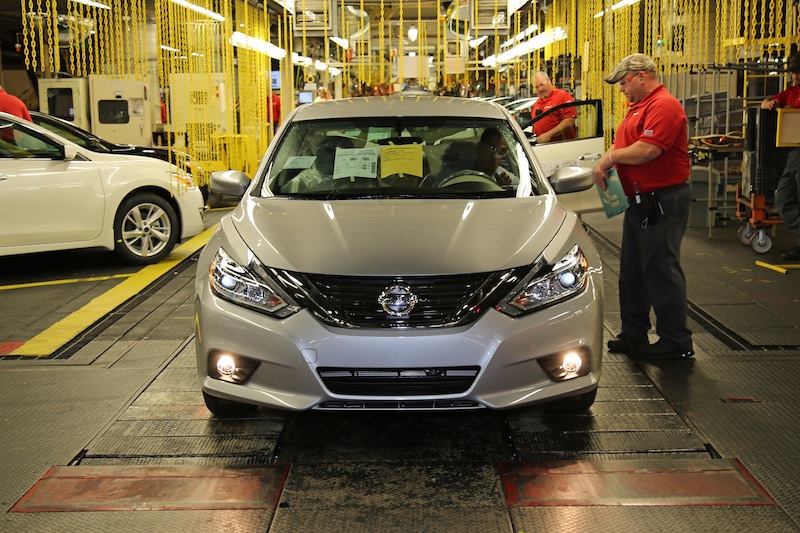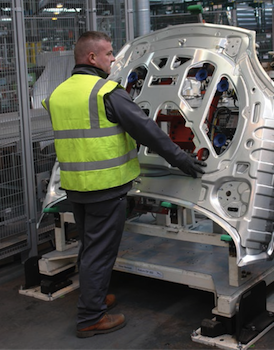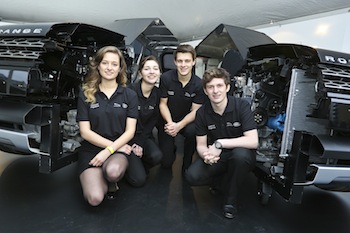If the automotive industry is to continue its progress, manufacturers will have to prioritise human resources

There are many factors behind this skills shortage, with one of the most challenging being the ability to entice young people to consider automotive manufacturing as a potential career. “The industry has an image problem: it’s stuck with the perception from the ‘70s and ‘80s of outdated factories filled with line jobs – not as innovative, inventive businesses, where workers develop and use the latest technology,” says Andy Graveson, national team manager – automotive at Festo, a pneumatic and electric-drive technology provider. “Careers in automotive manufacturing don’t appeal to young people, as we haven’t done a good job at selling the industry.”
In an effort to address these misconceptions, Rolls-Royce and Toyota recently invited school children and their parents to the opening of the University Technical College in Derby, UK, which is run in conjunction with the University of Derby and Derby College. “The idea was to present a different image of automotive manufacturing, not just to potential future employees, but also to their parents, who often aren’t too keen for their children to pursue a career in this sector,” explains Graveson.

The problem has arisen because the aims of schools and higher-education establishments are often at odds with the needs of the industry; focused on pushing children to go to university, either to hit targets or because they see it as the only way for their pupils to get a good job. According to Graveson, automotive manufacturers, industry bodies and the government need to work with educational establishments to promote apprenticeships as a viable and rewarding career for their students.
“Apprenticeships are only just beginning to be considered as an alternative; yet they provide students with a career as a foundation for life,” he says. “But while finding potential young employees can be difficult enough, finding ones with the right attitude and even the basic skills to make them employable seems nearly impossible. One automotive manufacturer interviewed more than 1,000 young people for starter careers. Out of this enormous number only about 25 were considered to be employable.”
As part of its efforts to develop a highly skilled workforce in the US, Nissan has partnered with the state of Tennessee to build an education and training facility at the OEM’s highest-performing manufacturing site in North America: Smyrna, which produced more than 600,000 vehicles in 2014.
The 150,000 sq.ft building will focus on areas such as robotics, maintenance and engineering, and will be completed by the end of 2016. The purpose of the facility is both to upskill existing workers through hands-on training and to develop the workforce of the future, equipping them with the skills to cope with the rapid pace of change in manufacturing.
Nissan has already created more than 5,000 manufacturing jobs in Tennessee since 2011 and now employs more than 12,000 individuals at its plants in Smyrna, Franklin and Decherd.
 Automotive has made rapid progress in technology. Training must keep pace.
Automotive has made rapid progress in technology. Training must keep pace.With baby boomers retiring over the next few years, the skills shortage only stands to get worse if suitable replacements cannot be found. Rachel Eade, automotive lead for the UK Government’s Business Growth Service, explains: “There is a very real issue around the ageing demographic of the industrial workforce and the need to reduce the average age of staff working in manufacturing.” Some companies have at least responded to the danger. “This has made SMEs change their approach to look at more innovative ways of recruiting and developing their own staff, with more investment channelled into apprenticeship programmes, leadership and management courses and ‘on-the-job’ upskilling,” says Eade. “We are also seeing a lot of investment in automation, and this requires staff to be trained in how to use this latest technology.”
Effective training in new technology is fundamental, given the rapid pace of innovation in the automotive industry, with advances such as the Internet of Things and Industry 4.0 reshaping the manufacturing landscape. Workers need training in areas such as advanced robotics and 3D printing, both of which are growing in prominence in the industry. While outside hiring is often a necessity, it is also a challenge. Yet training for existing workers, middle management, and senior leadership is also seriously lacking in some cases.
“It’s about making sure highly skilled people want to work in automotive manufacturing, and that people who are already there are able to grow and develop their skills as the industry advances,” says Graveson. This suggests that a different approach is needed from the industry to ensure that the pace of innovation does not outstrip skills development, and to address the image problem so that enough highly skilled workers – whether recent school leavers or mid-career professionals – want to work in the sector.
Enabling better communicationThis is an area where Industrial IP Advantage, a community set up by Cisco, Panduit and Rockwell Automation, hopes to bridge the gap. The organisation offers online training classes to meet the emerging needs of control engineers and IT professionals tasked with deploying a secure, holistic network architecture. While the courses are designed for engineers working in areas such as security, wireless networks, manufacturing execution systems, switches, routing and cabling, their use can be extended right across the factory.
“Automotive customers are adapting new architecture while also working with an increase in connected devices, both through the Internet of Things and BYOD [bring your own device], which are creating new business models,” says Dan McGrath, senior business development manager at Panduit. “The problem is that they don't have up-to-date specs on how to communicate this and we’re finding there is a skills gap between IT and operations.
“Our courses can help further collaboration between these two areas and enable employees to understand how they can unlock these new business models, whether they work on the plant floor diagnosing problems, or they are an engineer charged with bringing in new equipment, or they plan and set budgets for the next year. It’s about teaching a ‘common language’ to people in factories and providing a level playing field.”
Engaging employees, and enabling them to communicate and collaborate better, must occur throughout the working culture. “It’s not just about training on different machinery, it’s about communicating the future vision to harness and engage the minds of people at work,” says Graveson. “Companies that have a lack of clear mission, vision and values will find this a lot more difficult. But those that know where their company is headed can make step changes in improvements throughout every part of the company.”
Sakthi Automotive, an Indian automotive supplier, is turning a vacant high-school building in Detroit, Michigan, into a manufacturing campus and training centre for new engineers. The $31m investment is being driven by the company’s foray into the production of lightweight aluminum castings.
The Sakthi Manufacturing Campus will cover 1.2m sq.ft across four facilities. The Michigan Strategic Fund also committed $3.5m to support employment and business growth.
McGrath adds: “In terms of scalability, we not only offer these courses to engineers and IT staff, but also integrators and line builders – roles that wouldn’t have the opportunity to take part in these courses if they were classroom-based. We believe that this industry trend for e-learning will continue, especially as students can access materials through their mobile devices wherever they are, whenever they want.”
 Modern training methods incorporate elements of gaming, in an effort to appeal to the interests and experiences of youngsters
Modern training methods incorporate elements of gaming, in an effort to appeal to the interests and experiences of youngstersThese courses also incorporate a major new trend in online learning: ‘gamification’. This is where aspects of computer games are incorporated into training materials, such as rewards for completing tasks and leaderboards for competitions among colleagues. “Each course incorporates a range of quizzes, where you are awarded a badge according to how you do,” says McGrath. “It’s a good way to demonstrate your knowledge.”
The automotive industry needs to embrace these kinds of new developments in learning if it wants to remain at the forefront of innovation. “The rapid pace of change and advances in technology are going to happen one way or another, so manufacturers have to get onboard and upskill their employees or risk being left behind,” says Rigoni. “Equally, employees need to understand the importance of learning these new skill sets so they can build their careers.”
The Automotive Industrial Partnership was set up in March 2015 as a joint effort between the UK government and industry leaders such as Jaguar Land Rover, Bentley, BMW, Ford and Toyota to address the skills gap in the industry. The aim is to allow automotive manufacturers and other industry employers to develop both their current workforce and future employees so that they can compete on the global stage.
Initiatives within this scheme include apprenticeships in areas such as mechatronics, product design, and tool-making and maintenance; upskilling the existing workforce; and a 15-day programme offering vocational training and simulated work activities to provide a route to work for people aged 19 and over. Younger children will have the opportunity to experience what it is like to work in the automotive industry through a one-day production simulation, while those between the ages of 11 and 16 will have access to a six-day programme where they can develop skills such as team working, communications and problem solving. The partnership will also carry out research to establish the current and future skills needs of companies in this sector. It hopes to attract 10,000 apprentices and 2,000 graduates by 2018.
In early 2015, Toyota Manufacturing UK also started a new training programme, which is being funded by the Automotive Industrial Partnership. The Advanced Problem Solving programme takes Six Sigma techniques and embeds them into whichever problem-solving methodology is being applied. The training is a mixture of classroom-based learning, onsite coaching, project work and presentations or reviews. It is aimed at both engineers and management.





































